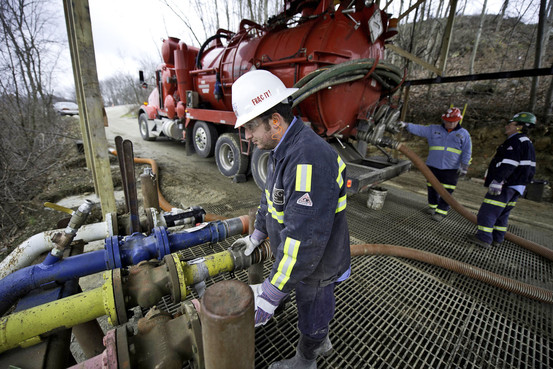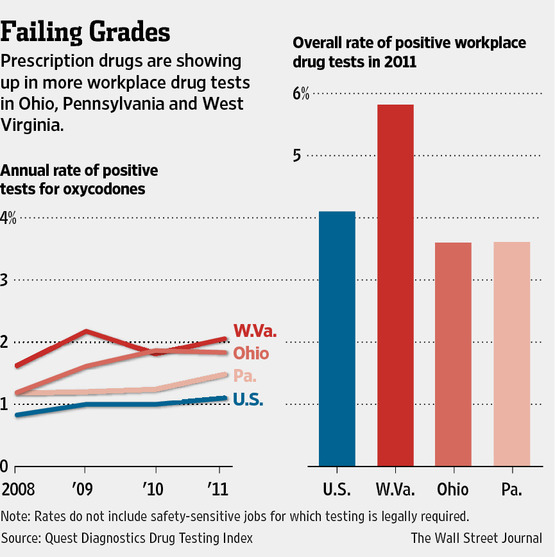
"It's getting harder and harder to find clean applicants," said Ms. Fuchs, chief executive of Weavertown Environmental Group. About 7% of Weavertown's applicants have been turned away in the past two years after failing screenings, roughly four times the national average for such workers.
The high rejection rate makes it difficult to keep jobs filled in an expanding industry that has frequent employee turnover due to the heavy labor involved, such as cleaning spills and other hazards at gas wells and power plants. Ms. Fuchs figures the company, which now employs about 200 people, will need to add 100 more workers in 2013 and hire others to fill vacancies caused by turnover.
In the debate about whether American workers have the right skills to fill jobs in manufacturing and growing sectors such as oil and gas extraction, failed drug tests are often an overlooked problem. But in parts of Pennsylvania, Ohio and West Virginia - a region undergoing an industrial transformation driven by shale gas - employers and others say widespread drug use, particularly the abuse of prescription drugs, is affecting hiring.
Nationwide, the rate of positive workplace drug tests has declined slightly over the past few years for most workers. But pre-employment tests detecting drugs in workers such as truckers and pipeline workers, who are required to be tested by federal law, have ticked back up in the past three years, to 1.8% in 2011 from 1.5% in 2009, in urine-analysis tests by Quest Diagnostics.
The prevalence of certain drugs is also on the rise. Quest found amphetamines in 24.6% of positive tests of federally mandated workers in 2011, up from 17.4% in 2009. Of the tests Quest conducted in the general workforce, pain relievers known as oxycodones were found in 3.1% of positive tests in 2011, from 2.7% in 2009. Positive rates for all workers in more than six million tests conducted by Quest in 2011 fell slightly to 3.5%, from 3.6% in 2009.
Across the U.S., workers test positive for oxycodones roughly twice as often in random on-the-job tests compared with pre-employment tests, suggesting some misuse once workers are hired, said Barry Sample, director of science and technology for employment solutions at Quest. Workers tested after accidents have a positive rate for oxycodones three times higher than pre-employment tests, which suggests the drugs impact safety practices, he said.
Health experts say drug dependency is particularly acute in Appalachia, which has a high percentage of older, blue-collar workers living in low-income areas. Workers who suffered on-the-job injuries and received prescription pain relievers as a result or endured long stretches of unemployment are more susceptible to drug use and abuse, said Neil Capretto, medical director at Gateway Rehabilitation Center, a drug-treatment organization with 20 locations in Pennsylvania and Ohio.
That poses challenges in the Pennsylvania-Ohio-West Virginia region, amid a wave of recruitment by natural-gas drillers and trucking, pipeline and well-services companies.
Employment in oil and gas extraction grew nearly 7% over the past year to 195,000 jobs nationwide, according to the Labor Department. Nearly all the companies have strict drug policies, with federal law requiring that some types of industry workers be tested to cut the risk of accidents involving trucks, hazardous materials and natural gas.
Elizabeth Carter, a recruiting consultant in New Concord, Ohio, who works with oil and gas companies in Ohio and Pennsylvania, said she typically finds that about one out of 15 job applicants fail pre-employment drug tests. "Where I see the increase is in prescription medication in the past five years," she said.
As a result, more employers are targeting veterans and volunteer firefighters, who have often gone through periodic drug testing, to find drug-free applicants, according to Rhonda Reda, executive director of the Ohio Oil and Gas Energy Education Program. In training programs at 45 colleges and career training centers, drug testing is "the No. 1 message" the group is highlighting, she said.
Several union officials in Ohio and West Virginia said they have been drug testing workers before and during multiyear apprenticeship programs for years and haven't seen an increase in drug use among members.
While some companies say more people are failing tests, health experts say that doesn't capture the full problem. That is because some people are still able to pass initial drug screenings - by remaining drug-free for a time before a test - and substance abuse remains common among workers.
As a result, some firms are beginning to use more-sophisticated testing. Union Drilling, a subsidiary of Houston-based Sidewinder Drilling Inc., switched from urine analysis to more sensitive hair-follicle tests in late 2011. The company partly credits the new tests for a 34% decline last year in safety incidents requiring more than first aid.




Reader Comments
to our Newsletter